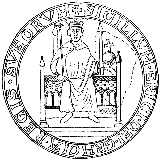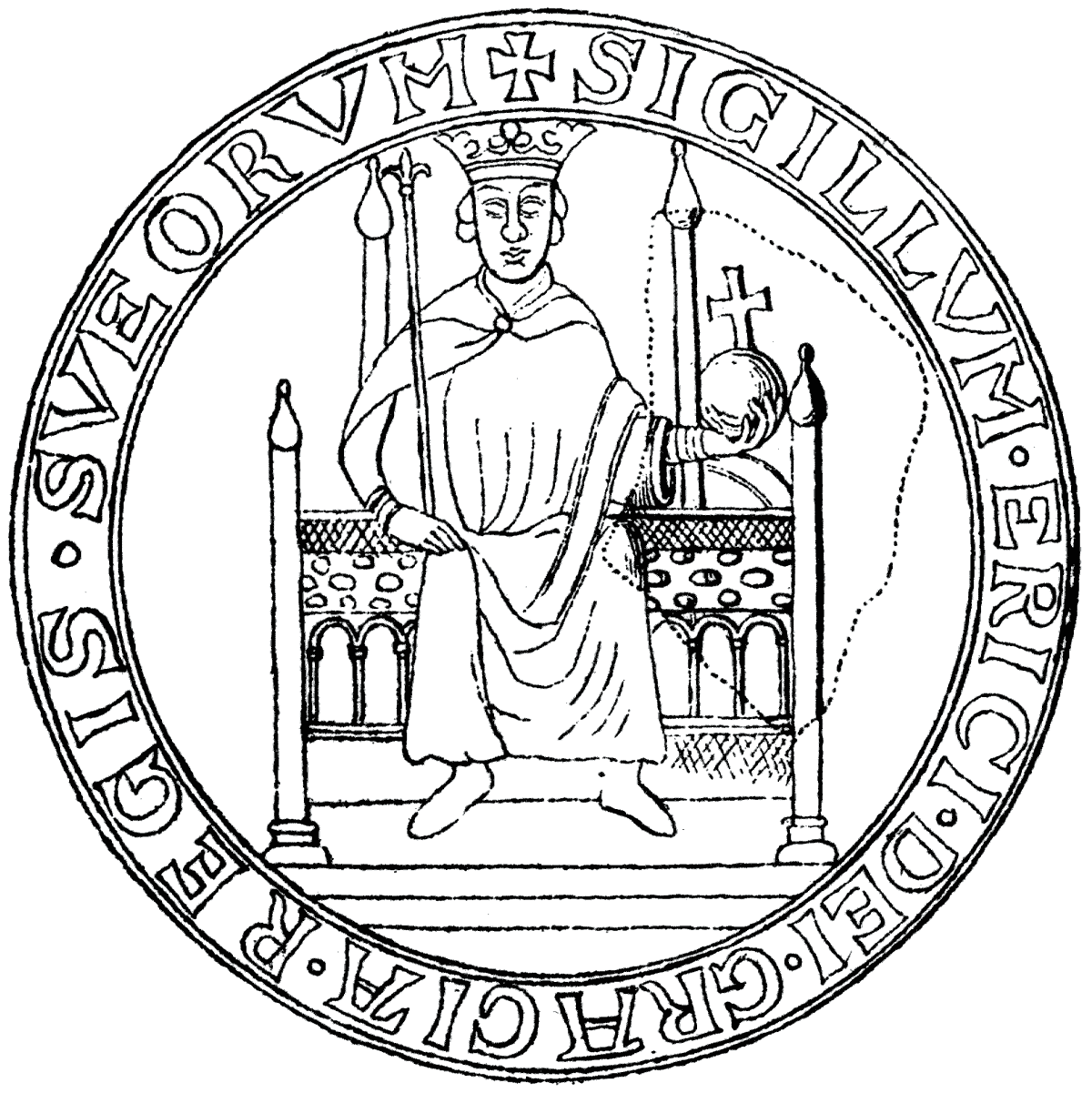
Eric XI of Sweden
Encyclopedia

Swedish language
Swedish is a North Germanic language, spoken by approximately 10 million people, predominantly in Sweden and parts of Finland, especially along its coast and on the Åland islands. It is largely mutually intelligible with Norwegian and Danish...
: Erik Eriksson läspe och halte; Old Norse
Old Norse
Old Norse is a North Germanic language that was spoken by inhabitants of Scandinavia and inhabitants of their overseas settlements during the Viking Age, until about 1300....
: Eiríkr Eiríksson (1216 – February 2, 1250) was king of Sweden
Sweden
Sweden , officially the Kingdom of Sweden , is a Nordic country on the Scandinavian Peninsula in Northern Europe. Sweden borders with Norway and Finland and is connected to Denmark by a bridge-tunnel across the Öresund....
in 1222–1229 and 1234–1250.
Background
Eric was the son of King Erik X of Sweden and Rikissa of DenmarkRikissa of Denmark
Richeza of Denmark was a medieval queen consort of Sweden, spouse of King Eric X of Sweden and mother of King Eric XI of Sweden.-Biography:...
, the daughter of King Valdemar I of Denmark
Valdemar I of Denmark
Valdemar I of Denmark , also known as Valdemar the Great, was King of Denmark from 1157 until 1182.-Biography:...
. According to the chronicle Erikskrönikan written in the early 1320s, Eric is said to have been partly lame. Eric was born after his father, King Eric X, had already died, and in the meantime the fifteen-year-old John I of Sweden
John I of Sweden
John I of Sweden was a Swedish king elected in 1216. -Background:John was the son of King Sverker II of Sweden of the House of Sverker and Queen Ingegerd of the Bjälbo dynasty. King Sverker had been beaten in the Battle of Lena and later killed in the Battle of Gestilren in 1210...
from the rival House of Sverker
House of Sverker
After the extinction of the House of Stenkil and the ascension of Sverker I of Sweden in 1130, a civil war commenced. In the beginning, there were several pretenders, of whom Sverker I emerged as victorious, for a time...
had been hailed king by the Swedish aristocracy, against the will of the Pope
Pope
The Pope is the Bishop of Rome, a position that makes him the leader of the worldwide Catholic Church . In the Catholic Church, the Pope is regarded as the successor of Saint Peter, the Apostle...
, who preferred Eric as king.
Referring to Eric Ericson as King Eric XI is a later invention, counting backwards from Eric XIV
Eric XIV of Sweden
-Family and descendants:Eric XIV had several relationships before his marriage. With Agda Persdotter he had four daughters:#Margareta Eriksdotter , married 1592 to Olov Simonsson, vicar of Horn....
(1560–68). He and his brother Charles IX
Charles IX of Sweden
Charles IX of Sweden also Carl, was King of Sweden from 1604 until his death. He was the youngest son of King Gustav I of Sweden and his second wife, Margaret Leijonhufvud, brother of Eric XIV and John III of Sweden, and uncle of Sigismund III Vasa king of both Sweden and Poland...
(1604–1611) adopted numerals according to a fictitious history of Sweden. The amount of Swedish monarchs named Eric before Eric XIV (at least seven) is unknown, going back into prehistory
Prehistory
Prehistory is the span of time before recorded history. Prehistory can refer to the period of human existence before the availability of those written records with which recorded history begins. More broadly, it refers to all the time preceding human existence and the invention of writing...
, and none of them used numerals. It would be speculative to try to affix a mathematically accurate one to this king.
Reign
When King John I died in 1222, the five-year-old Eric was hailed king, with a distant male cousin who was adult, first as leader of the regency council and then as co-regent with Knut HolmgerssonCanute II of Sweden
Canute II Holmgersson, called the Tall , was King of Sweden from 1229 until his death 1234. He may have been a great grandson of Eric the Saint, for the sagas give Filip Eriksson, Eric's youngest son, as the father of Holmger, Canute's father...
. Knut was a member of the council which ruled Sweden. In 1229, after having been a minor king in seven years, Eric was overthrown after the battle of Olustra (slaget vid Olustra). The battle is believed to have taken place in Olustra in Södermanland
Södermanland
', sometimes referred to under its Latin form Sudermannia or Sudermania, is a historical province or landskap on the south eastern coast of Sweden. It borders Östergötland, Närke, Västmanland and Uppland. It is also bounded by lake Mälaren and the Baltic sea.In Swedish, the province name is...
, although Alvastra
Alvastra
Alvastra is a small village in Ödeshög Municipality in eastern Sweden. It is known for being the seat of the Cistercian Alvastra Abbey in the Middle Ages. After the Swedish Lutheran reformation in the 1530s, the monastery was demolished, never to be rebuilt....
in Östergötland
Östergötland
Östergötland, English exonym: East Gothland, is one of the traditional provinces of Sweden in the south of Sweden. It borders Småland, Västergötland, Närke, Södermanland, and the Baltic Sea. In older English literature, one might also encounter the Latinized version, Ostrogothia...
has been mentioned as a possible site. After his loss, the young king fled to Denmark where his uncle was King Valdemar II of Denmark
Valdemar II of Denmark
Valdemar II , called Valdemar the Victorious or Valdemar the Conqueror , was the King of Denmark from 1202 until his death in 1241. The nickname Sejr is a later invention and was not used during the King's own lifetime...
. Knut Holmgersson was crowned King Canute II of Sweden
Canute II of Sweden
Canute II Holmgersson, called the Tall , was King of Sweden from 1229 until his death 1234. He may have been a great grandson of Eric the Saint, for the sagas give Filip Eriksson, Eric's youngest son, as the father of Holmger, Canute's father...
in 1231 but his time in office was short and he died 1234.
After King Canute's death, Eric returned and ruled until his own death in 1250. Eric was married to Queen Catherine
Catherine of Ymseborg
-Succession:...
, daughter of (Jarl) Sune Folkason of Bjälbo and an heiress of the House of Sverker. Commonly, sources say that Eric was childless, but some sources claim that he had a couple of baby daughters who died. Eric was buried in the monastery of Varnhem Abbey
Varnhem Abbey
Varnhem Abbey in Varnhem, Västergötland, Sweden was founded around 1150 by monks of the Cistercian Order from Alvastra Abbey in Östergötland.The Cistercian Order used the same floor plan for all its abbeys, which makes it possible to easily locate the different rooms and halls regardless of the...
in Västergötland
Västergötland
', English exonym: West Gothland, is one of the 25 traditional non-administrative provinces of Sweden , situated in the southwest of Sweden. In older English literature one may also encounter the Latinized version Westrogothia....
.
In 1236, King Eric's (apparently youngest) sister Ingeborg had been married to Birger Magnusson
Birger jarl
, or Birger Magnusson, was a Swedish statesman, Jarl of Sweden and a member of the House of Bjelbo, who played a pivotal role in the consolidation of Sweden. Birger also led the Second Swedish Crusade, which established Swedish rule in Finland. Additionally, he is traditionally attributed to have...
, in Birger's first marriage. Birger Magnusson was the son of a female heiress of the Sverker dynasty and a member of the House of Bjelbo. Their under aged eldest son Valdemar
Valdemar I of Sweden
Valdemar, English also Waldemar; , was King of Sweden 1250–1275.-Biography:Valdemar was the son of princess Ingeborg Eriksdotter of Sweden and Birger jarl, from the House of Bjelbo. During the first sixteen years of his reign, it was Birger Jarl who was the real ruler...
was elected king 1250 to succeed Eric, possibly by-passing the sons,if such existed, of Ingeborg's elder sisters. Birger Magnusson became the Regent, holding the true power in Sweden until his own death in 1266.
Skáldatal
Skáldatal
Skáldatal is a short prose work in Old Norse. It is preserved in two manuscripts: DG 11, or Codex Uppsaliensis, which is one of the four main manuscripts of the Prose Edda , and AM 761 a 4to , which also contains Skaldic poems...
reports that Óláfr Þórðarson
Óláfr Þórðarson
Óláfr Þórðarson was an Icelandic skald and scholar who was born about 1210 and died in 1259. He is usually called Óláfr hvítaskáld in contrast to a contemporary skald called Óláfr svartaskáld...
was one of Eric's court skald
Skald
The skald was a member of a group of poets, whose courtly poetry is associated with the courts of Scandinavian and Icelandic leaders during the Viking Age, who composed and performed renditions of aspects of what we now characterise as Old Norse poetry .The most prevalent metre of skaldic poetry is...
s.
Other sources
- Lagerqvist, Lars O. ; Åberg, Nils Litet lexikon över Sveriges regenter (Boda kyrkby: Vincent förlag. 2004) ISBN 91-87064-43-X
- Harrison, Dick Jarlens sekel - En berättelse om 1200-talets Sverige ( Stockholm: Ordfront, 2002) ISBN 91-7324-999-8
- Lindström, Henrik; Lindström, Fredrik Svitjods undergång och Sveriges födelse (Stockholm: Albert Bonniers förlag. 2006) ISBN 91-0-010789-1.

